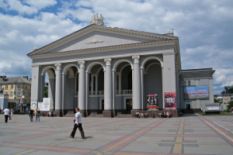Yuliya will be a speaker at Connecting Women 2018 Conference organized by Edinstvennaya women's magazine. The event will take place on November 4 in Kyiv, giving visitors a chance to listen to more than 25 speakers that will share their secrets of successful career.
How did the idea of Made in Ukraine experiment appear and why did you choose a blog as its main platform?
In 2013, long read materials were more in trend than they are now. Moreover, I am an economic journalist and for me writing long reads and analyzing the situation is simply natural. I could not tell everything I would like in mere 140 symbols without the proper fact-checking. As for the project’s creation, there was a rather personal goal behind it — I wanted to return to journalism from PR.
I carried the idea of Made in Ukraine for a long time: in 2011, I did not manage to make it true but luckily made it happen in 2013. At that time, the law on advertising in the press and television was rather harsh, so posting information in a blog and as an experiment allowed me to name the brands directly, test their products and be as “objectively subjective” as I could.
In 2014-2015, Ukraine experienced a real boom of local brands from clothing to household goods. However, approximately 30% of the brands left the market. What could be the reason behind this?
 I can actually analyze the situation since a much earlier period: in 2011, when I tried to launch Made in Ukraine for the first time, Ukrainian goods were mostly present as joint productions. Some joint ventures tried to run their business and quite successfully existed on their own. When I approached this topic in 2013, it turned out that the craft production was quickly developing in Ukraine. At that time we did not know fancy words like ‘craft’ and that trend was just around the corner. Scandinavian trend watchers then predicted that craft would develop in the next 10 years.
I can actually analyze the situation since a much earlier period: in 2011, when I tried to launch Made in Ukraine for the first time, Ukrainian goods were mostly present as joint productions. Some joint ventures tried to run their business and quite successfully existed on their own. When I approached this topic in 2013, it turned out that the craft production was quickly developing in Ukraine. At that time we did not know fancy words like ‘craft’ and that trend was just around the corner. Scandinavian trend watchers then predicted that craft would develop in the next 10 years.
2013 was also the period of Yanukovych’s reign and a period of stagnation in Ukraine. When I mentioned Made in Ukraine, everyone I knew shook their heads and said, “Why do you do this, why do you even want to do it?” It was a pure journalistic curiosity. I used to write about the privatization of the 1990s in Ukraine and now I wanted to check what actually remained from the Soviet Union. If rockets and large-diameter pipes are not of interest to everyone, daily usage goods actually can interest many.
Ukrainians also had a very long and desperate search for self-identification until 2017 Revolution of Dignity. After it happened, the Ukrainian production used the prepared soil: entrepreneurs who could navigate in a rapidly changing space skyrocketed during the wave of economic patriotism. In addition to those who already existed and were not afraid to declare themselves as Ukrainian-made start-ups massively appeared all over the country.
But a wave is a wave — it quickly rose and fell just as quickly. Those who saw it as a way to make quick money and did not reinvent themselves as a serious business quickly collapsed. This is an absolutely normal, natural process. Moreover, the collapse of businesses will continue — someone new will appear while businesses, even the big-name ones, will collapse. As a result, in 2-3 years we will see a quite powerful structured market with leaders, middle players, and young brands that want to enter the market.
Today, many buyers that want to buy Ukrainian goods are put off by high prices. How do we achieve the balance of price-quality and can it happen soon?
Yes, you just need to carefully study the economy. If we talk about the cosmetics and light industry segments, we need to understand that almost all the fabrics used in Ukrainian production are imported. We do not grow cotton, there are no silkworms — Ukrainian manufacturers buy fabrics and materials in foreign currency, which is why currency fluctuation also plays a role in the price.
Besides, wages in Ukraine are not as low as in China, for example, therefore our products cannot be competing with Chinese ones — and should not. We want to have fair market wages and pay taxes to the state. That’s why Ukrainian goods cannot be cheap.
Ukrainian consumers have a pet peeve — if they like something, as a rule, they are silent about it, but if they aren’t satisfied, they lave angry reviews. How can local businesses cope with such a mentality?
Unfortunately, I do not know how to deal with the national mentality. That is true, our society is somewhat bitter because of the remnants of the Soviet mindset — we are not used to praising, but to criticism. To be worthy of praise, the product or business has to be simply something supernatural.
Think of a classic example: if you go to booking.com, you can see that the responses in English are mostly positive, like “The room may be a bit small but it has a nice view and the hotel served good breakfasts”. Whereas the reviews in Russian mostly sound like this: “Good God, what did we pay money for? Tiny room, awful staff, what a nightmare.” These are remnants of the Soviet mindset.
Each of us must develop qualities to equally point out both strengths and weaknesses.
Tell us how you compiled the “#madeinukraine: Shop, Eat, Travel” guide.
 This idea of guide appeared right after the presentation of the first book [Looking for Made in Ukraine] because I wanted to do something even more ambitious. I invited Aurora Ogorodnik and Lala Tarapakina to be my co-authors as experts in the fields of travel and gastronomy.
This idea of guide appeared right after the presentation of the first book [Looking for Made in Ukraine] because I wanted to do something even more ambitious. I invited Aurora Ogorodnik and Lala Tarapakina to be my co-authors as experts in the fields of travel and gastronomy.
The book was compiled according to several parameters. First, it had to include spots that we could definitely recommend to our friends and tourists. The places had to be checked out by us personally, that’s why the three of us visited every place described in the book.
Finally, these places should have been fairly easy accessed. We had to ditch two chapters because our photographer was not able to get to the location. We realized that no matter how wonderful the place was, we cannot recommend it since traveling to it was difficult. From a total of 160 places we kept 105, and the changed 6 chapters during the last translation of the book. As for brands, the book mentions local businesses with stable good quality.
Are there any other English-language guidebooks about Ukraine you plan to release?
.jpg) Yes, we have recently sent a new guide in print. It will have 320 pages, published in English in the pocketbook format. ‘Ukrainian’s Travel Guide’ will be a classic guide about all Ukraine, developed by our team. I can say that it will have a beautiful, modern layout made by the designers who work in Berlin, and a lot of photos from popular Instagram photographers.
Yes, we have recently sent a new guide in print. It will have 320 pages, published in English in the pocketbook format. ‘Ukrainian’s Travel Guide’ will be a classic guide about all Ukraine, developed by our team. I can say that it will have a beautiful, modern layout made by the designers who work in Berlin, and a lot of photos from popular Instagram photographers.
It's great because many Ukrainian guidebooks in English have become rather outdated over the years.
Indeed. Our guide has much in common with products of the leading publishers of the world. We need to show a beautiful product. I hope that by the end of the year we will also release guidebooks dedicated to Kyiv, Odesa, and the Carpathian routes.
I would definitely buy the Carpathian guide. Nowadays there’s a lack of practical information even on the official websites.
Yes, unfortunately, the Carpathian guide is the most difficult to compile. It is very difficult to step away from the “Lviv - Lviv Carpathians” or “Ivano-Frankivsk - Frankivsk Carpathians” axes, but we gathered information that only concerns the mountains themselves. Where would you advise to eat, shop, and travel the foreigners that come to Ukraine? I suggest opening our guide and going to the place nearest to them because all the 105 addresses that we offer in the book are worthy of a visit.
As for my personal rating, it is traveling in Zakarpattia, trying the local wines. Then, I would travel to the Ternopil region and exploring the local castles and estates. I would definitely go to one of Dima Borisov’s restaurants; my favorites are Bessarabia and Kanapa on Andriivskyi Descent. As for shopping, it is, of course, best done in Odesa. If we talk about Kyiv, then Cabanchi.com and Kachorovska Atelier. Also, stock on any Ukrainian ceramics — it experiences a real boom these days.
Photos provided by Yuliya Savostina.









